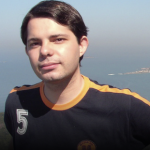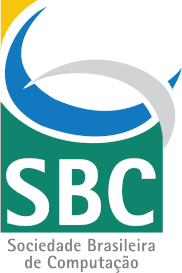Tutorials
Object Tracking in Virtual and Augmented Reality
Mauro Pichiliani
Note: it is desirable that the participants have some experience with the development of Virtual Reality, Augmented Reality or Mixed Reality applications.
The current generation of Virtual Reality (VR) devices and Augmented Reality (AR) applications are increasingly focused on the accuracy of body parts tracking, such as hands and body movement. However, physical object tracking and their use in VR and AR have technical and practical challenges. This tutorial will present the following techniques for tracking of physical objects: sensors, computer vision and devices that require user instrumentation.
 Mauro Pichiliani holds a BS degree in Computer Science, MS and PhD degrees from ITA (Instituto Tecnológico de Aeronáutica) and UNC (University of North Carolina). He has been working for more than 20 years using various technologies and has participated in projects involving mobile applications, virtual reality, databases and artificial intelligence. He is currently a scientist at the research laboratory at IBM Brazil, where he conducts research in the areas of artificial intelligence, collaborative systems and human-machine interaction. He has published books, academic articles, courses, workshops and tutorials in the main scientific conferences of the HCI area.
Mauro Pichiliani holds a BS degree in Computer Science, MS and PhD degrees from ITA (Instituto Tecnológico de Aeronáutica) and UNC (University of North Carolina). He has been working for more than 20 years using various technologies and has participated in projects involving mobile applications, virtual reality, databases and artificial intelligence. He is currently a scientist at the research laboratory at IBM Brazil, where he conducts research in the areas of artificial intelligence, collaborative systems and human-machine interaction. He has published books, academic articles, courses, workshops and tutorials in the main scientific conferences of the HCI area.
Augmented Reality Using Vuforia and Unity
Derzu Omaia and Liliane dos Santos Machado
Instructions: Unity platform must be installed (free download at https://store.unity.com/, in individual plans), creating an account. During the installation process, the download of the Visual Studio development environment will be offered, that is also recommended. Complete download: 6.5 GB.
Augmented reality (AR) is a mechanism for visualizing, directly or indirectly, in real-time, a real physical environment, over which computer-generated information is added. AR aims to integrate virtual elements into the real world’s vision, increasing user perception and interaction with the environment. Several visualization devices can be used for this visual integration, including mobile devices such as tablets and smartphones. With the popularization of mobile devices, it became possible to create low cost and easy to spread AR applications. Several AR development tools have been proposed for different platforms, among them, the Vuforia library stands out together with the Unity platform, since they offer advanced features in a simple way. This tutorial aims to present the process of creating AR applications using the Vuforia library in conjunction with the Unity platform, showing how to use from basic to advanced features of this library. The objective is to enable participants to develop and execute AR applications for the most diverse application areas. The approach to be used will be totally practical, going from the application definition stage, discussion about the quality of markers and the recognition system, to the interaction with animations and virtual elements.
 Derzu Omaia has a degree in Computer Science from the Federal University of Paraíba (UFPB), and a MS degree in Computer Science from the Graduate Program in Computer Science (PPGI) at UFPB. He is currently a PhD student at the Federal University of Pernambuco (UFPE) and Professor at the Federal University of Paraíba (UFPB). He has experience in Computer Science, with emphasis on Digital TV (middleware Ginga, interactive applications, multiplexing), Digital Image Processing and Computer Vision.
Derzu Omaia has a degree in Computer Science from the Federal University of Paraíba (UFPB), and a MS degree in Computer Science from the Graduate Program in Computer Science (PPGI) at UFPB. He is currently a PhD student at the Federal University of Pernambuco (UFPE) and Professor at the Federal University of Paraíba (UFPB). He has experience in Computer Science, with emphasis on Digital TV (middleware Ginga, interactive applications, multiplexing), Digital Image Processing and Computer Vision.
 Liliane dos Santos Machado concluded her PhD in Electrical Engineering at Universidade de São Paulo (USP). Nowadays she is an associated professor at the Department of Informatics of the Federal University of Paraíba (Brazil) and advises in three graduate programs: Informatics, Decision Making Models and Health, and Computing, Communication and Arts. Her research includes interdisciplinary themes and computer science. She has works published in several scientific journals and conferences, participates in journals editorial boards and coordinates several research projects. She is a member of the Brazilian Computer Society. Her curriculum has the more frequent words in scientific production: virtual reality, serious games, haptics, online evaluation, medical education and education technologies. She is a Brazilian researcher supported by the National Council for Scientific and Technological Development (CNPq) since 2010. From June/2014 to November/2018 was the president of the Virtual Reality Special Group at the Brazilian Computer Society. From August/2015 to June/2018 was a member of the CNPq board CA-DT. From September to December of 2018 was visiting professor at University of Alberta (Edmonton/Canada), developing research on engagement and gameflow for virtual reality systems.
Liliane dos Santos Machado concluded her PhD in Electrical Engineering at Universidade de São Paulo (USP). Nowadays she is an associated professor at the Department of Informatics of the Federal University of Paraíba (Brazil) and advises in three graduate programs: Informatics, Decision Making Models and Health, and Computing, Communication and Arts. Her research includes interdisciplinary themes and computer science. She has works published in several scientific journals and conferences, participates in journals editorial boards and coordinates several research projects. She is a member of the Brazilian Computer Society. Her curriculum has the more frequent words in scientific production: virtual reality, serious games, haptics, online evaluation, medical education and education technologies. She is a Brazilian researcher supported by the National Council for Scientific and Technological Development (CNPq) since 2010. From June/2014 to November/2018 was the president of the Virtual Reality Special Group at the Brazilian Computer Society. From August/2015 to June/2018 was a member of the CNPq board CA-DT. From September to December of 2018 was visiting professor at University of Alberta (Edmonton/Canada), developing research on engagement and gameflow for virtual reality systems.
Copyright © SVR 2020
svr2020@cin.ufpe.br

